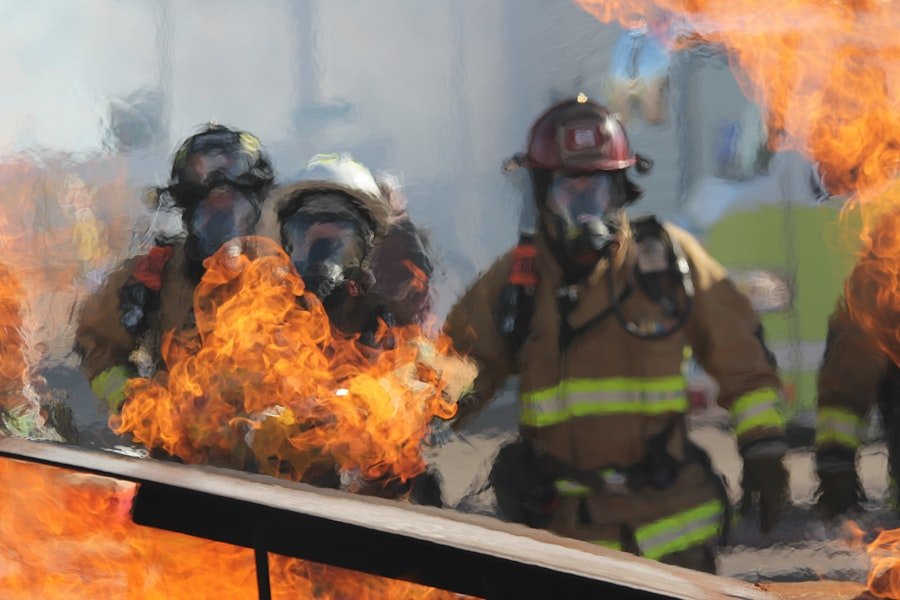Fire risks are a critical concern across various sectors, with each industry facing unique challenges and hazards that can lead to devastating consequences. The potential for fire incidents is not only a matter of property loss but also poses significant threats to human life, environmental safety, and economic stability. Understanding the specific fire risks associated with different industries is essential for developing effective prevention strategies and response plans.
This article delves into the fire hazards prevalent in several key sectors, including hospitality, manufacturing, healthcare, retail, agriculture, and education, highlighting the distinctive characteristics and risks inherent to each. The nature of fire risks varies significantly from one industry to another, influenced by factors such as the materials used, operational processes, and the presence of flammable substances.
By examining these risks in detail, stakeholders can better appreciate the importance of tailored fire safety measures that address the specific vulnerabilities of their respective industries. This comprehensive analysis aims to shed light on the multifaceted nature of fire hazards and underscore the necessity for proactive fire prevention strategies.
Key Takeaways
- Different industries face unique fire risks and hazards that require specific prevention measures.
- The hospitality and restaurant industry is prone to kitchen fires, electrical fires, and flammable materials.
- The manufacturing and industrial sector faces fire risks from machinery malfunctions, chemical storage, and combustible dust.
- Healthcare and elderly care facilities need to be vigilant against electrical fires, medical equipment malfunctions, and fire hazards in patient rooms.
- Retail and wholesale businesses should focus on fire prevention for storage areas, electrical systems, and flammable merchandise.
Fire Hazards in the Hospitality and Restaurant Industry
The hospitality and restaurant industry is particularly susceptible to fire hazards due to the combination of cooking processes, high occupancy levels, and the use of various flammable materials. Commercial kitchens are often equipped with deep fryers, grills, and ovens that generate significant heat and can ignite nearby combustible materials if not properly maintained. Grease buildup in kitchen exhaust systems is a common issue that can lead to dangerous fires if not regularly cleaned.
The National Fire Protection Association (NFPA) reports that cooking equipment is the leading cause of restaurant fires, accounting for nearly 60% of all incidents in this sector. In addition to cooking-related hazards, the hospitality industry faces risks associated with electrical systems and heating equipment. Hotels and restaurants often utilize extensive electrical wiring to power lighting, heating, and cooling systems.
Overloaded circuits or faulty wiring can lead to electrical fires, which can spread rapidly in environments filled with flammable furnishings and decorations. Furthermore, the presence of candles in dining areas or guest rooms adds another layer of risk, as unattended flames can easily ignite nearby materials. To mitigate these hazards, establishments must implement rigorous fire safety protocols, including regular inspections of cooking equipment, electrical systems, and fire suppression systems.
Fire Risks in the Manufacturing and Industrial Sector
The manufacturing and industrial sector presents a unique set of fire risks due to the diverse range of materials and processes involved in production. Factories often utilize flammable liquids, gases, and solids in their operations, which can create hazardous environments if not managed properly. For example, chemical manufacturing plants may store large quantities of volatile substances that can ignite under certain conditions.
The NFPA emphasizes that industrial facilities account for a significant percentage of fire incidents, with many resulting in severe injuries or fatalities. Moreover, the presence of heavy machinery and equipment in manufacturing settings can contribute to fire risks. Equipment malfunctions or improper maintenance can lead to overheating or sparks that ignite flammable materials nearby.
Additionally, dust accumulation from raw materials can create explosive atmospheres if not adequately controlled. Industries such as woodworking or metalworking are particularly vulnerable to dust-related fires. To address these risks, manufacturers must adopt comprehensive safety measures, including regular maintenance schedules for equipment, proper storage of hazardous materials, and employee training on fire prevention practices.
Fire Hazards in the Healthcare and Elderly Care Industry
The healthcare and elderly care industry faces distinct fire hazards due to the presence of vulnerable populations and specialized equipment. Hospitals and nursing homes often house patients who may have limited mobility or cognitive impairments, making evacuation during a fire emergency particularly challenging. Additionally, healthcare facilities utilize various electrical devices and medical equipment that can pose fire risks if not properly maintained.
For instance, oxygen tanks used for patients can create explosive environments if exposed to open flames or sparks. Another significant concern in healthcare settings is the use of flammable materials such as alcohol-based hand sanitizers and cleaning agents. These substances are essential for infection control but can also contribute to fire hazards if not stored correctly.
The NFPA highlights that healthcare facilities must implement stringent fire safety protocols to protect both patients and staff. This includes regular fire drills, clear evacuation plans tailored to the needs of patients with mobility challenges, and ongoing training for staff on recognizing potential fire hazards.
Fire Risks in the Retail and Wholesale Industry
The retail and wholesale industry encounters various fire risks stemming from its diverse product offerings and high customer traffic. Retail stores often stock flammable merchandise such as clothing, paper products, and cleaning supplies, which can easily ignite if exposed to heat sources or open flames. Additionally, many retail establishments utilize extensive electrical systems for lighting and point-of-sale equipment, increasing the risk of electrical fires if circuits are overloaded or wiring is faulty.
Warehouse facilities within the wholesale sector face unique challenges as well. The storage of large quantities of goods can create obstacles for emergency exits and hinder evacuation efforts during a fire incident. Furthermore, improper stacking of products can lead to blockages that prevent access to firefighting equipment or hinder escape routes.
To mitigate these risks, retailers must conduct regular fire safety assessments, ensure compliance with local fire codes, and provide employee training on proper storage practices and emergency response procedures.
Fire Hazards in the Agriculture and Farming Sector
The agriculture and farming sector presents a distinct set of fire hazards due to its reliance on machinery, chemicals, and natural materials. Farm equipment such as tractors and combines can generate sparks or heat during operation, posing a risk of ignition in dry fields or near flammable materials like hay or grain. The NFPA notes that agricultural fires can escalate quickly due to the presence of combustible crops and structures such as barns or silos.
Additionally, farmers often use various chemicals for pest control or fertilization that can be highly flammable. Improper storage or handling of these substances can lead to dangerous situations where fires may ignite unexpectedly. Moreover, seasonal factors such as drought conditions can exacerbate fire risks by creating dry landscapes that are more susceptible to ignition from machinery or lightning strikes.
To address these challenges, farmers should implement comprehensive fire prevention strategies that include regular maintenance of equipment, proper storage of chemicals away from ignition sources, and adherence to local regulations regarding fire safety.
Fire Risks in the Education and Childcare Industry
The education and childcare industry faces unique fire risks due to the presence of young children who may not fully understand emergency procedures or the dangers associated with fire. Schools and daycare centers often have large numbers of occupants in confined spaces, making evacuation during a fire emergency critical yet challenging. The NFPA emphasizes that educational institutions must prioritize fire safety measures to protect students and staff alike.
Common fire hazards in schools include faulty electrical systems, heating equipment malfunctions, and the use of flammable materials in art or science classes. Additionally, many schools have kitchens that prepare meals for students, which introduces cooking-related fire risks similar to those found in restaurants. To enhance safety measures, educational institutions should conduct regular fire drills tailored to different age groups, ensuring that children understand evacuation routes and procedures.
Furthermore, staff training on identifying potential hazards and responding effectively during emergencies is essential for fostering a culture of safety within educational environments.
Conclusion and Recommendations for Fire Prevention
Fire prevention is a critical aspect of operational safety across all industries discussed above. Each sector faces unique challenges that require tailored approaches to mitigate risks effectively. Organizations must prioritize regular training for employees on recognizing potential hazards and implementing emergency response plans tailored to their specific environments.
Additionally, conducting routine inspections of equipment and facilities is essential for identifying vulnerabilities before they escalate into dangerous situations. Investing in advanced fire detection systems and suppression technologies can significantly enhance safety measures across industries. For instance, installing automatic sprinkler systems in high-risk areas such as kitchens or warehouses can provide an additional layer of protection against potential fires.
Furthermore, fostering a culture of safety through ongoing education about fire risks can empower employees to take proactive measures in preventing incidents before they occur. By understanding the specific fire hazards associated with their respective industries and implementing comprehensive prevention strategies, organizations can significantly reduce the likelihood of devastating fires while ensuring the safety of their employees and customers alike.
FAQs
What are the common fire risks by industry?
Common fire risks by industry include electrical malfunctions, combustible materials, flammable liquids, and industrial equipment.
Which industries face the highest fire hazards?
Industries such as manufacturing, construction, hospitality, and healthcare are among those that face the highest fire hazards due to the presence of flammable materials, electrical equipment, and high occupancy levels.
How can businesses mitigate fire risks?
Businesses can mitigate fire risks by implementing fire safety protocols, conducting regular fire risk assessments, installing fire detection and suppression systems, providing employee training, and maintaining proper housekeeping to reduce the accumulation of combustible materials.
What are the potential consequences of fires in the workplace?
Fires in the workplace can lead to property damage, business interruption, injuries or fatalities, environmental damage, and financial losses. It can also damage a company’s reputation and lead to legal liabilities.








